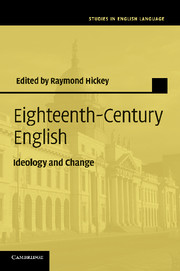Book contents
- Frontmatter
- Contents
- List of figures
- List of maps
- List of tables
- Notes on contributors
- Preface
- 1 Attitudes and concerns in eighteenth-century English
- 2 Prescriptivism and the suppression of variation
- 3 Women's grammars
- 4 Eighteenth-century women and their norms of correctness
- 5 Lowth as an icon of prescriptivism
- 6 Queeney Thrale and the teaching of English grammar
- 7 Coalitions, networks, and discourse communities in Augustan England: The Spectator and the early eighteenth-century essay
- 8 Contextualising eighteenth-century politeness: social distinction and metaphorical levelling
- 9 Expressive speech acts and politeness in eighteenth-century English
- 10 Variation and change in eighteenth-century English
- 11 Variation in sentential complements in eighteenth- and nineteenth-century English: a processing-based explanation
- 12 Nationality and standardisation in eighteenth-century Scotland
- 13 English in eighteenth-century Ireland
- 14 Changes and continuities in dialect grammar
- 15 ‘Be pleased to report expressly’: the development of a public style in Late Modern English business and official correspondence
- 16 Registering the language – dictionaries, diction and the art of elocution
- Timeline for the eighteenth century
- References
- Late modern English language studies
- Indexes
10 - Variation and change in eighteenth-century English
Published online by Cambridge University Press: 06 December 2010
- Frontmatter
- Contents
- List of figures
- List of maps
- List of tables
- Notes on contributors
- Preface
- 1 Attitudes and concerns in eighteenth-century English
- 2 Prescriptivism and the suppression of variation
- 3 Women's grammars
- 4 Eighteenth-century women and their norms of correctness
- 5 Lowth as an icon of prescriptivism
- 6 Queeney Thrale and the teaching of English grammar
- 7 Coalitions, networks, and discourse communities in Augustan England: The Spectator and the early eighteenth-century essay
- 8 Contextualising eighteenth-century politeness: social distinction and metaphorical levelling
- 9 Expressive speech acts and politeness in eighteenth-century English
- 10 Variation and change in eighteenth-century English
- 11 Variation in sentential complements in eighteenth- and nineteenth-century English: a processing-based explanation
- 12 Nationality and standardisation in eighteenth-century Scotland
- 13 English in eighteenth-century Ireland
- 14 Changes and continuities in dialect grammar
- 15 ‘Be pleased to report expressly’: the development of a public style in Late Modern English business and official correspondence
- 16 Registering the language – dictionaries, diction and the art of elocution
- Timeline for the eighteenth century
- References
- Late modern English language studies
- Indexes
Summary
Discussions of regulating (and regularising) English began in earnest with the restoration of the monarchy in 1660 and the intellectual renaissance that followed it. In the Royal Society, a committee was formed to consider the language, but its deliberations were interrupted by the Great Fire of London. Of course a whole variety of issues were raised for the committee's consideration, but the principal one concerned making English sufficiently copious to enable serious intellectual work to be conducted in it. Thus, the task was to clarify the vocabulary. To these intellectuals the problem was to explore the relation between words and ideas, and making the language correct was very much a subsidiary goal. John Wilkins, a Royal Society member, even thought it might be possible to create a universal language in which every conceivable idea might be expressed in every language. The problem he hoped to solve was not correctness but the necessity of removing ambiguity (see Bailey 2003).
About 1700, however, things began to change. In 1704, with the Battle of Blenheim, Britain (and its allies) defeated the French who had been both militarily and culturally the centre of European civilisation. England rose to the opportunity to assert sovereignty, including sovereignty over its own language. Latin soon ceased to be the language of learning; French began to diminish as the international language of diplomacy. English could now be the language of both.
- Type
- Chapter
- Information
- Eighteenth-Century EnglishIdeology and Change, pp. 182 - 199Publisher: Cambridge University PressPrint publication year: 2010
- 2
- Cited by



